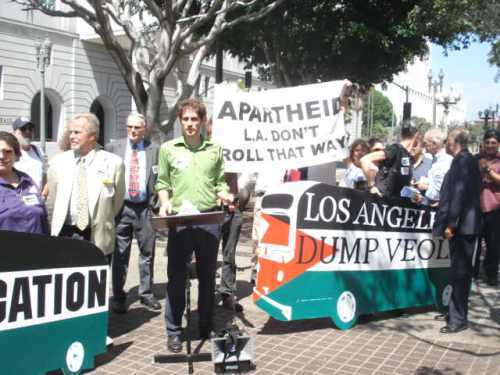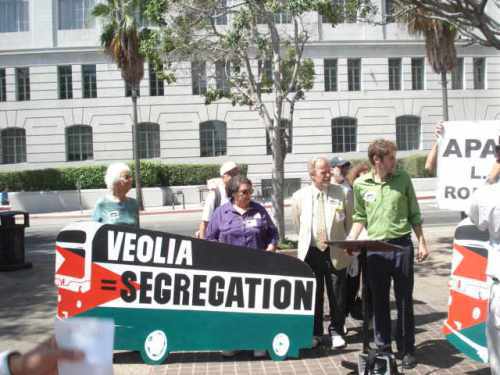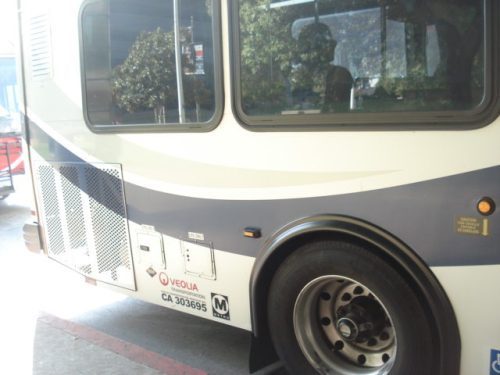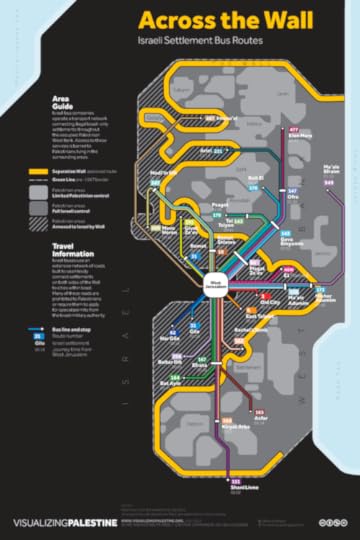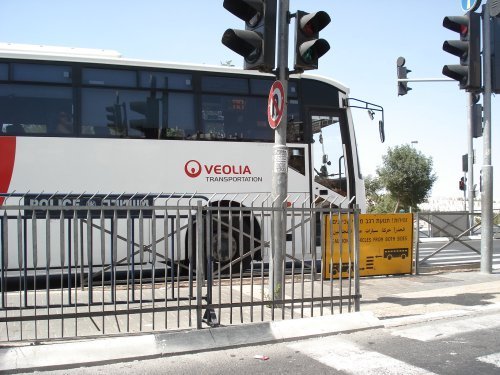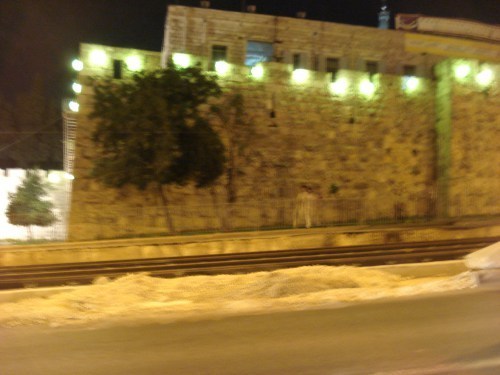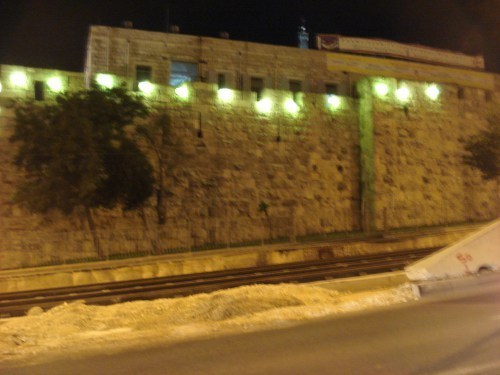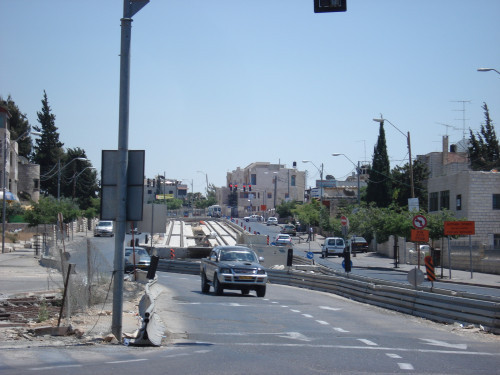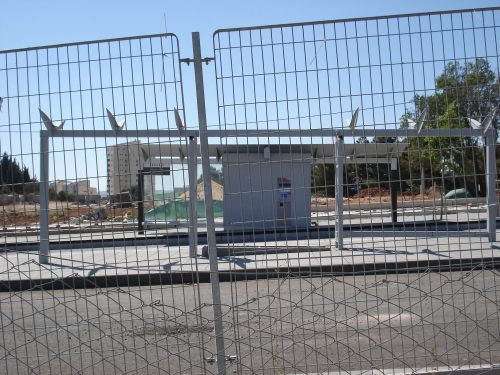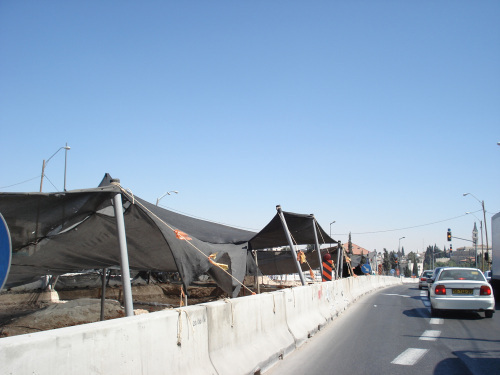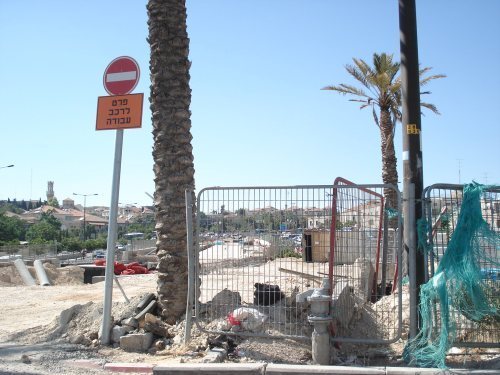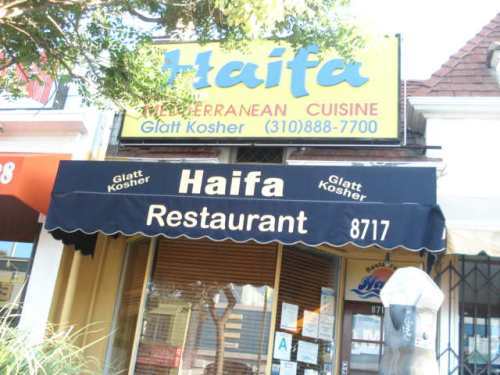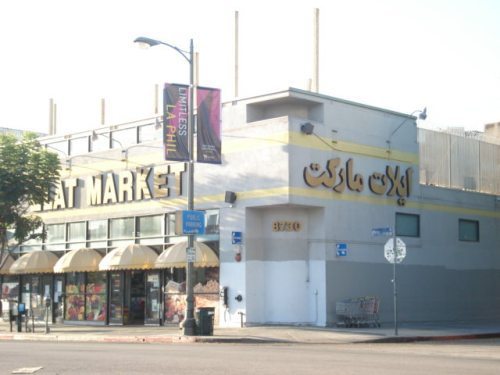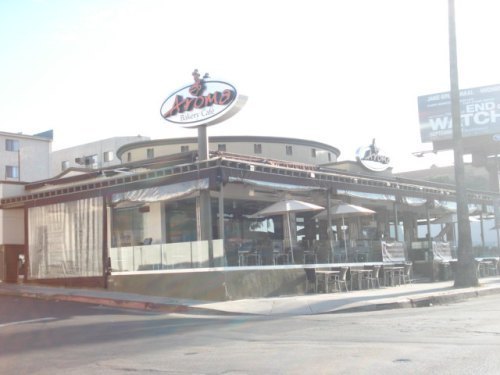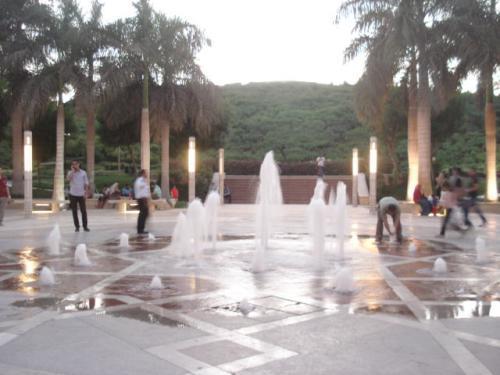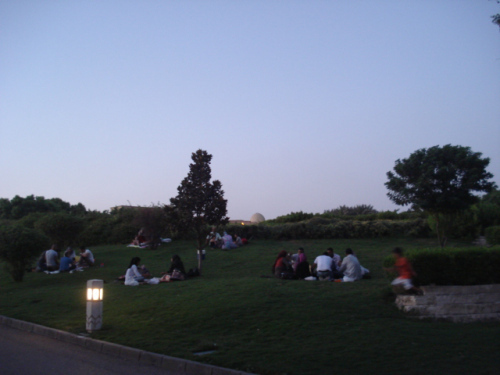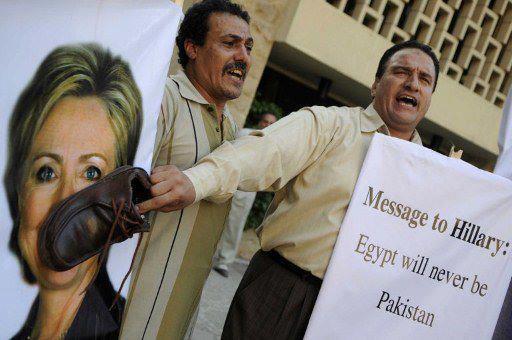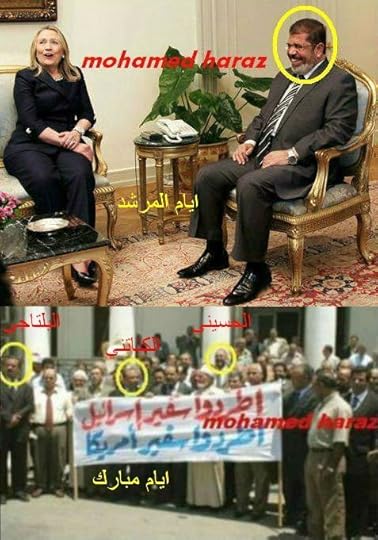Marcy Jane Knopf-Newman's Blog, page 5
September 12, 2012
Los Angeles City Council Transportation Committee Votes to Stand with #Veolia and Israeli Apartheid #BDS
Today I entered the halls of city hall in Los Angeles, I think, for the first time. It is entirely possible I was there when I was young and cannot recall the memory. It’s funny to me because although I am a Los Angeleno, I came of age in Ohio and my activism really began there. I often go to protests and demonstrations when I’m home, but I’ve never gone to speak before city council here as I used to do in Cincinnati, for instance, when I was actively fighting against the homophobic Issue 3.
It felt a bit daunting, perhaps, because I know that this space where I signed up to speak was a place where my grandmother, Marian Gibbons, founder of Hollywood Heritage, spoke so many times before. In fact, as I sat there in the transportation committee’s meeting space, thinking about what I would say when I addressed them, I noticed a man whose face, and eventually, name I began to recognize. He spoke at my grandmother’s funeral. Tom LaBonge has been working in Los Angeles city politics for ages and he worked with my grandmother at some point, but I cannot recall exactly what they did together.
I decided that I’d try to speak to this relationship somehow instead of addressing the same old points about boycotting Veolia, the transportation company that Los Angeles is working to renew a contract with. Everyone else (there were 33 speakers asking to dump this contract and 5 speakers seeking to maintain it) addressed the usual points. I talked about my grandmother’s history as an activist preserving and resuscitating Hollywood, which inevitably provided me with an model for how to be an activist, albeit in a different context. But while my grandma saved and renovated historic landmarks, I fight for human rights–for Palestinians to not be exiled from their lands, for Palestinian homes to not be demolished, for Palestinians to be able to return to their land. At the end of the day just like my grandma fought destruction of something that was valuable to her, I support Palestinians in their effort to preserve their life, livelihood, and homes. Veolia, the French company I spoke against today, profits off the destruction of Palestinian homes and livelihoods by creating and maintaining a Jewish-only transportation system connecting Jewish-only colonies.
I may not have been the most persuasive speaker, but at least LaBonge addressed me in his closing remarks, indicating that perhaps he heard what I had to say. In general, it was quite a disappointing meeting. Most of the council members there were either flipping through paperwork (which may or may not be related to what were addressing today) or played on their cell phones. The one who acted like he was listening, Paul Koretz, although this Jon Lovitz lookalike appeared constipated most of the time, made it expressly clear that he supports Israel. Although he stated this to the room, it was evident a bit before then because when 4 of the 5 Veolia supporters spoke (a team of people from the Jewish Federation of Los Angeles) he let all of them go over the 1 minute time limit without reminding them that they had gone over. Everyone else was interrupted and reminded of that fact.

The speakers (see Uprising radio above video for another example) who addressed the main arguments made some excellent points, especially about this city where I grew up. I’ve been a bit harsh and frustrated with my hometown of late because of the fascist policies the state and the city have been passing. But as a city, I was reminded today, that Los Angeles has often done the right thing. And this was a point that many people drove home today:
* In 1984 Los Angeles was one of the first major cities in the U.S. to divest from South Africa during the apartheid regime
* In 2008 and 2009 Los Angeles’ fire and police commissions terminated relationships with a program run by the Boy Scouts of America because of its explicit discriminatory policies against LGBTQ people
* In 2010 Los Angeles city council voted to boycott Arizona and any companies based there because of Arizona’s draconian anti-immigrant law SB 1070
But it seems that Los Angeles would want to uphold its moral stance and be consistent. When the question today came up about whether or not it is illegal for the state of California or the city of Los Angeles to boycott Israel, a couple of important response came up (not the least of which is the fact that Veolia is a French, not an Israeli company):
* Nothing in U.S. law or California law prohibits the city of Los Angeles from refusing to do business with Veolia because of its human rights violations in occupied Palestine. A boycott even against Israel or an Israeli company would only be prohibited under the Export Administration Act (EAA) if the specific boycott is initiated by foreign countries, specifically, the official government of a foreign country.
There are many other important points that are specific to Veolia’s violation of international law for its apartheid transportation system in occupied Palestine. Jewish Voice for Peace, which organized today’s protest, has a fact sheet where they lay out more reasons why one should boycott Veolia. There is also an article on the Mondoweiss website that details more of these points by some of the people who spoke today.
In the end, we lost. They voted unanimously to continue its contract with Veolia. Unlike Stockholm, Melbourne, Bourdeaux, Dublin, Swansea and the Hague, Los Angeles seems to want to continue its relationship with Veolia in spite of its human rights violations. My grandma, although she had her battles with city hall to be sure, never had to face the seemingly insurmountable Zionist hold on American politics. It’s significantly easier to get Americans, especially in Los Angeles, to be sympathetic about preserving its recent cinematic past.
The last time I was in Palestine, in 2009, I took photographs in al Quds (Jerusalem) of the Veolia light rail project that was being built by dividing and destroying various aspects of Palestinian neighborhoods for the sake of the colonial transportation system. Here are some of those photographs:
Filed under: Apartheid, Boycott, Divestment & Sanctions, Colonialism, Economy, Human Rights, International Law, Occupation, Palestine, U.S. Foreign Policy, Zionism Tagged: Al Quds, Apartheid, boy scouts, california, city council, dash buses, discrimination, divest, export administration act, hollywood, hollywood heritage, jerusalem, jewish voice for peace, lgbtq, light rail, Los Angeles, marian gibbons, paul koretz, South Africa, tom labonge, veolia


September 8, 2012
The Fascist State of California
In my last blog post I focused on aspects of being in Los Angeles that particularly irked me. Little did I know, it gets worse. Two items of note:
1. The mayor of Los Angeles, Antonio Villaraigosa addressed the Democratic National Convention this week in which he proceeded to establish the capital of an illegal colonial occupation in Palestine (i.e., that Jerusalem is the capital of Israel) as a part of the Democratic party’s platform:

Anyone who knows Villaraigosa’s politics should not be surprised by his actions. Los Angelenos likely remember his efforts to collaborate with Israel on a variety of issues:
In just a few days, we signed agreements to strengthen security at our airport and enhance our counterterrorism capabilities. We initiated partnerships to protect our ports and reduce our carbon footprint. We took a series of steps to revitalize the L.A. River, expand the city’s water conservation and recycling initiatives and invest in the technologies of tomorrow. From homeland security and public safety to environmental innovation and green development, Los Angeles is set to receive the best Israel has to offer in the fields where the Jewish state leads the world — and Los Angeles will be better off as a result.
But it gets worse. The state of California passed a resolution a couple of weeks ago that indicates its real fascist tendencies:
The resolution, which was passed without debate and without input from community groups, “recognizes recent actions by officials of public postsecondary educational institutions in California and calls upon those institutions to increase their efforts to swiftly and unequivocally condemn acts of anti-Semitism on their campuses and to utilize existing resources, such as the European Union Agency for Fundamental Rights’ working definition of anti-Semitism, to help guide campus discussion about, and promote, as appropriate, educational programs for combating anti-Semitism on their campuses.”
HR 35 is a non-binding resolution and has no policy mandate. But a careful reading of the vocabulary and wording has direct similarities to accusations made by Zionist groups and students against Palestine solidarity activism and Muslim student groups on UC campuses in California. The resolution calls for public institutions, for example, to condemn “student- and faculty-sponsored boycott, divestment, and sanction campaigns against Israel that are a means of demonizing Israel and seek to harm the Jewish state.”
While the resolution is non-binding, it indicates the tenor of the state’s politics and does not bode well in light of freedoms on college campuses, as witnessed by the Irvine 11 and others.
Filed under: Apartheid, Colonialism, Elections, Obama, Palestine, U.S. Foreign Policy, U.S. Policy Tagged: anti-Semitism, Antonio Villaraigosa, california, democratic party, dnc, HR 35, irvine 11, jerusalem, Los Angeles


September 3, 2012
Home, but not
Home is a bit of a tough word for me–even more now than usual. It’s the first time I’ve been home in almost two years and it’s the first time for me to return home without my family house to go to. Last time I came home I attended my grandmother’s funeral and then buried her along with my grandfather, mother, and uncle. Although my mom died twenty years ago, her ashes were not interned anywhere public. And my grandmother kept the ashes of my uncle and grandfather so that they could all be buried together. I visited the cemetery the other day thinking it might be comforting, but it isn’t really. It’s the first time I have had a chance to visit my family in a cemetery–which I longed for after my mother’s death–but two decades of learning how to deal with the death of a loved one where ever you are in the world made me feel a bit detached from the experience.
It is also challenging to be back in an environment that feels increasingly like little Tel Aviv. There was always a large Jewish community in Los Angeles, but the Israeli population seems to have increased exponentially. Two summers ago I found it impossible to escape youth clad in “Israeli Defense Forces” t-shirts–something I know I never saw as a girl even in the Zionist circles I was involved in. That summer was also the first time I saw the street sign in Beverly Hills commemorating the founder of Zionism, Theodor Herzl (see above).
This summer I was greeted at the airport by my usual transportation and to my surprise saw the Veolia logo painted on it. Having already paid the fees, I did not have a choice at the time to ride it, so I did. But it gets worse: the public transportation system in Los Angeles seems to have been hijacked by Veolia. What’s wrong with Veolia? In a nutshell, according to the folks at Mondoweiss:
Veolia operates bus lines that connect Jewish-only settlements to Israel. These buses do not stop in Palestinian towns and use Israeli-only roads, built on land confiscated from the Palestinians for the exclusive use of Israelis and settlers. West Bank Palestinians are denied access in a throwback arrangement reminiscent of the Jim Crow South.
Then there is the Jerusalem Light Rail Project Veolia is constructing which will link illegal Jewish settlements in East Jerusalem to Israel. That tramway not only helps make the illegal settlements permanent but also serves as a critical component of the Israeli settlements infrastructure, “undermining any chances of a just peace for the Palestinian people,” according to the international human rights group Global Exchange.
Not having a car in Los Angeles puts me at the mercy of this system making it difficult to boycott one of the companies that most deserves it. Additionally, Cirque du Soleil is playing in Hollywood now, another target of the BDS campaign because they performed in Israel. At the Los Angeles County Museum of art there is currently an Israeli artist’s exhibition on display as well.
It’s not just these aspects of being home that make it difficult. It’s also the every day stuff. Walking around my friends’ neighborhood every day it is impossible not to feel like one is surrounded by Israelis. As soon as I turn the corner onto the main street by her house, I’m confronted with Israeli flags.
It’s interesting to think about all of the Jewish area businesses and the constant whining about people conflating Judaism and Zionism, but can people really be blamed when those lines are blurred by Jewish Zionists?
Another example of this is Simon Wiesenthal’s Museum of “Tolerance.” I went there in 2000 or 2001 not knowing who ran it or anything about it. I wasn’t sure what to expect, but certainly not a Nazi holocaust museum masquerading as a museum that is inclusive of other historical and current oppressions. There was about 5 feet devoted to African Americans and then the rest was all about Nazi Germany. I’m not sure if it is still this way, but one look at their teacher resources and it is clear that they continue to expend most of their energy only on anti-Jewish oppression. It is not just this that I find deeply upsetting about the Museum of Tolerance. It would be ironic, if Wiesenthal were not a Zionist, that the Museum of Tolerance’s plans to build a branch of their museum in al-Quds (Jerusalem). Why is this a problem? Because they are going to build it on the grounds of an ancient, significant Muslim cemetery. In other words, illustrating the complete lack of tolerance for Muslims, Palestinians, and the dead. Saree Makdisi wrote about this two years ago in the Los Angeles Times:
In 2002, the Wiesenthal Center — which had been given part of the cemetery by the city of Jerusalem — announced that architect Frank Gehry would design a complex to be called the Center for Human Dignity-Museum of Tolerance Jerusalem. Ground was broken in 2004. Palestinian and Muslim concerns were ignored until a lawsuit led to the suspension of excavation in 2006. In 2008, the Israeli Supreme Court — dismissing the appeals not only of Palestinians with relatives buried there but also the protests of Jews appalled by desecration of any cemetery — cleared the way for the project.
The center claims to see nothing wrong with erecting what its leader, Rabbi Marvin Hier, calls “a great landmark promoting the principles of mutual respect and social responsibility” on top of what remains of another people’s cemetery. It has resorted to endless dodges to support its claim.
There is a campaign fighting this called the Mamilla Campaign, which explains the details of the crime being committed by the Wiesenthal/Museum of Tolerance people. There is also a petition to sign on the site. Also the always fabulous Never Before Campaign released a video explaining and supporting the Mamilla Campaign a couple of years ago that is worth a watch:

There are so many other forms of visual assault I feel as I walk down the streets where so many Jewish/Zionist shops have co-opted the names of the places in Palestine that Zionists stole. A sampling of what I see in this Los Angeles neighborhood is below.
 The final photograph above is of an Israeli coffee chain, Aroma, that seems to have opened a new branch in Los Angeles. Here is how the Jewish Journal describes the original cafe:
The final photograph above is of an Israeli coffee chain, Aroma, that seems to have opened a new branch in Los Angeles. Here is how the Jewish Journal describes the original cafe:
First established in Encino in 2005, Aroma is more than a cafe — it’s like an unofficial branch of the Israeli Consulate. Walk in, and you might as well be in Israel. Cute Israeli waitresses serve customers like they’re still jet-lagged from their flight here. Tel Aviv-style Israeli posses dressed in nightclub gear spread their chairs and legs out like they own the place, cigarettes in tow, cell phones on tabletops. And like back home, the action takes place late into the night.
Finally, there is also one other landmark of note here. It is a school that I wrote about in my recent book, but I never saw it in person. I kept walking by, thinking it was familiar, but couldn’t place the name. Then I remembered.
Shalhevet is a Jewish day school that, for me, is famous because they fired a teacher, Alexander Maksik, for teaching Naomi Shihab Nye’s young adult novel Habibi. Since I already deal with this at length in the second chapter of my book, I’ll just lead people to the two links about this episode (here and here).
So this is my home, but not. Because it is hard to feel at home somewhere–especially when you grew up there–when your family and the people you shared the important memories with are no longer around. But also because this city has become Israelized in ways that seem implacable.
Filed under: Boycott, Divestment & Sanctions, Human Rights, Palestine, Racism, Zionism Tagged: Al Quds, alexander maksik, aroma, bds, beverly hills, cirque du soleil, hollywood, holocaust, jerusalem, light rail, Los Angeles, los angeles county museum of art, mamilla, Museum of Tolerance, naomi shihab nye, nazi, never before campaign, saree makdisi, shalhevet school, simon wiesenthal, super shuttle, tel aviv, theodor herzl, veolia


August 26, 2012
Bob
I mean one particular Bob: Spongebob Square Pants. I used to watch the show some years ago with my son and found it clever. However, I was a bit perplexed by the Spongebob renaissance I witnessed in Cairo last month. There was almost nowhere you could look without some Spongebob image on a tshirt or a towel or even Sponebob himself making an appearance, walking down the street. I’d love to know why he’s suddenly so popular since I haven’t seen the same sort of iconography in Beirut, for example. Most Egyptians I asked didn’t know why.
[image error]
[image error]
[image error]
[image error]
[image error]
[image error]
[image error]
[image error]
[image error]
Filed under: Egypt


August 17, 2012
Back in Beirut
The plan was to write another couple of blog entries about Cairo, but the photographs that would have amplified the story are being held hostage on my computer that won’t let me log on any more. So for now I’m just reporting that I arrived back in Beirut, for a brief week, before returning to the U.S. for a visit (see speaking link above for dates of my upcoming speaking engagements in California). The plan was almost interrupted when the airport road into Beirut was shut down the night before I left. Here is a video from Al Jazeera:

I found it all a bit odd, especially because of the U.S. embassy warning that As’ad AbuKhalil posted on his blog just two days earlier:
“The U.S. Embassy has received reports of an increased possibility of attacks against U.S. citizens in Lebanon. Possible threats include kidnapping, the potential for an upsurge in violence, the escalation of family or neighborhood disputes, as well as U.S. citizens being the target of terrorist attacks in Lebanon. U.S. Embassy personnel remain under strict travel restrictions, and all U.S. citizens are urged to take additional security precautions.” I would love to see the sources for those reports, would you not? And don’t you like the reference to “escalation of family or neighborhood disputes”??
It is almost as if the Americans were predicting the attacks. Of course, the kidnapping predicted is not at all targeting Americans, although it should given the logic being used (it is targeting Syrians who are against the Asad regime in Syria as well as regional powers assisting them like Qatar, Turkey, Saudi Arabia). It certainly makes me wonder what role the Americans are playing Syria and Lebanon right now.
These kidnappings are not the work of militias or political parties. They are the work of Lebanese families seeking revenge for their family members who have been kidnapped in Syria. But it got quite out of hand the other night with journalists–even those on the same political side–were beaten up. Fortunately things seem to have calmed down now, but there are still threats about what may happen after Eid in the coming days.
Here is some more writing on the topic
“Al-Moqdad Republic” in al-Akhbar
“Armed Lebanese Kidnap 11 Syrians” in al-Akhbar
“Second Turkish Citizen Kidnapped” in al-Akhbar
“Families of Kidnapped Lebanese in Syria Cut Off Access to Airport in Beirut” in Jadaliyya
And for the humorous take on all this, check out this new Twitter account, Moqdaddy.
Filed under: Lebanon, Militarization, Syria, Turkey, U.S. Foreign Policy Tagged: al-moqdad, asad, beirut, kidnap, qatar, saudi arabia


August 11, 2012
Cairene Renovations
Today I revisited one of my favorite places in Cairo–the part of the old city where you can see old Ottoman homes, like Beit el Sehemy, that have been restored. Last time I was here, I think there was only one such house in isolation. But this time there are a number of homes, and entire streets, that have been renovated. Now there is also Beit el Harawy, Beit Zeinab Khatoun, and Beit el Sit el Wasila. Three of these homes are like a museum, which you can pay a small fee for a guided tour. And now concerts and other artistic events are held in these spaces. But much of this neighborhood’s refurbished buildings appear in the form of workshops where craftsmen can create products for sale in the shops in other parts of Khan el Khalili.
It seems that the woman behind the rehabilitation of much of this area, and indeed a great deal of Egypt, is Mona Zakaria whose vision restored the streets, homes, and shops (see articles on her work here and here). The workmanship is incredible in every respect as one can see from the photographs below. What was also new this time around was a boutique hotel called Le Riad, which is stunningly restored and decorated. The furniture may not be precisely of the same era of the house, but it is beautiful and tasteful. It is lovely to see that preserving old Cairo has expanded over the past eight years.
[image error]
[image error]
[image error]
[image error]
[image error]
[image error]
[image error]
[image error]
[image error]
[image error]
[image error]
[image error]
[image error]
[image error]
[image error]
[image error]
[image error]
[image error]
[image error]
[image error]
[image error]
[image error]
[image error]
[image error]
Filed under: Egypt Tagged: beit el harawy, beit el sehemy, beit el sit el wasila, beit zeinab khatoun, khan khalili, le riad, mona zakaria, ottoman


August 7, 2012
Green in the City
It has been eight years since I spent the summer in Cairo and this is my first visit back. There has been a lot that has changed here, uprising not withstanding (see Jadaliyya on Egypt’s recent past, especially here, here, and here). Given that I am merely a visitor here, and a foreigner at that, it is not my place to write about the political scene in Egypt. Others (linked to above) are doing that better than I can.
Instead I have been doing my part to help the Egyptian economy, which has suffered from less tourist traffic since the uprising. The number of craft shops seems to have doubled or tripled since 2004. And the kinds of crafts being sold in the city or in the souq seems to have changed, too. Either that or I am merely noticing different types of objects. I am especially in love with the Berber embroidery and drafts from Siwa, which I would get on the bus and visit (there are some amazing ecolodges there) if it were not so hot outside. And because it is Ramadan there are additional craft fairs around the city at night, such as the one I went to a couple of weeks ago at Darb 1718.
The other thing that has been most striking to me over the past couple of weeks is al-Azhar Park. The park is built in the heart of a poor community in old, Islamic Cairo not far from Khan Khalili market. Although the arial shot above makes it seem like the park is an oasis in a midst of a concrete jungle, much of Cairo is actually pretty Green. If you drive along the Nile, for example, it is incredibly lush. Spending the last couple of years in Beirut, and Amman before that, I had forgotten how much I miss green spaces. There are very few public parks in Beirut for picnicking or for children to swing or play football. Although Ba’albek does have quite a lovely park where you can do those things.
At the entrance of al-Azhar Park you see a beautiful fountain, which children play in. The park does have an entrance fee (the equivalent of about $1), but if you are one of the families who live in the area you get in for about $.25. As a result, it the grass is filled with families having picnic iftar dinners while children run around on the playground. There is also a year-round souq and a Ramadan outdoor souq with beautiful crafts for sale.
It is refreshing to see such a wide, open space in the center of an urban metropolis. The weather is cooler there, the people seem happy, and the energy is amazing. I walked around the perimeter of the park last weekend right around iftar began (this hour of the day is not ideal for photography, but the images should give readers a small slice of what it looks like).
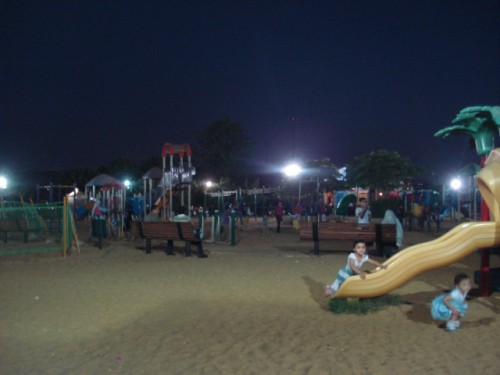 The park is also filled with beautiful landscaping, gardens (plant names are identified in Arabic and English on placards). There are restaurants and cafes and an amphitheater hosting terrific music.
The park is also filled with beautiful landscaping, gardens (plant names are identified in Arabic and English on placards). There are restaurants and cafes and an amphitheater hosting terrific music.
My first weekend here I saw Oumeima el Khalil (photograph above) and last weekend I went to Dina el Wadidi’s concert. Wadidi sings in a band that fuses the incredible sounds of the accordion, violin, piano, and tabla (also bass and electric guitar, which unfortunately drown out the other beautiful sounds). One of the many people sitting around me filming the concert on their cell phones posted one of the songs on Youtube:

As I enjoyed the park I wondered about its construction. I thought about the people in Beirut who are working for greening the city. Every time I look at the enormous port I imagine how beautiful it would be as a green park with football fields, playgrounds for children, and areas for families to picnic. But, of course, this is Solidere territory (the best article on the history and context of how Solidere ruined downtown Beirut see Saree Makdisi’s articles here and here). The contrast between the once public space, albeit not green, of downtown Beirut and the public space of al-Azhar Park is striking in many ways (although similar kinds of encroachments on downtown Cairo were part of Mubarak’s re-imagining of the city). Whereas Solidere wants to keep poor people out, al-Azhar at least appears to be working to make all families able to access its space. Poor people may not be able to afford to buy crafts or eat at the restaurants, but for under $1 they can picnic and their children have a place to run around and play.
If only it were that simple. I did a little research to see how this park was created. A foreign corporation, the Aga Khan Trust, financed the construction of this park. I was told by an Egyptian friend that the fees that one pays when entering go to that corporation for about thirty years before Egyptians may retain control over their own park (reminds me of the Suez Canal and the British). The microfinance division of Aga Khan collaborates with USAID on a number of projects, including one in Aswan, Egypt (they also have a numer of projects in Afghanistan and elsewhere in collaboration with USAID). It is unclear what role USAID has had in the building of al-Azhar Park. But there are some indications that they played a role. One document says, for example, that through the American Research Center, that USAID funded a part of a project in the park, but it doesn’t specify what. Another article suggests that USAID, along with the Ford Foundation, helped to fund part of the municipal underground water beneath the park.
Of course all this transpired under the Mubarak regime. Indeed, Suzanne Mubarak was apparently quite the champion of the park. It’s not yet clear to me how much of the park has been funded with USAID. But even a dime from that entity spells danger. But I am not at all surprised. This is what USAID does best: it appears to be a lovely gift from the Americans to the Egyptians (or the Haitians or the Palestinians), but in reality it is a mechanism of domination and control. This is why ALBA nations recently pledged to kick out USAID from their countries in a bold anti-imperialist move.
Egypt has been controlled by USAID since Sadat’s treacherous signing of the Camp David Accords in 1979, which gave Egyptians back the Sinai Peninsula (though not military control over it) and sold out the Palestinians. In exchange for this agreement, Egyptian people began to receive funds and imports from the United States. But it is not so simple.
Jason Hickel explains how this works in the most important sector, the agricultural sector:
To push along the process of neoliberal reform, USAid has given $200 million each year to the Egyptian government in handouts to encourage “continuing reduction in tariffs” and the privatisation of 314 government-owned companies. Furthermore, USAid devotes some 25 per cent of its budget to a special Commodity Import Programme designed to help Egypt buy American-made goods and reinforce bilateral trade.
Programmes like these have proven to be devastating for many Egyptians: they tend to undercut local manufactures, encourage foreign monopolies, concentrate wealth in the hands of political cronies and ultimately contribute to unemployment, which (depending on the measure used) has risen to 25 per cent in recent years and reaches as high as 30 per cent among the young.
Some of the most extreme neoliberal measures have been directed at Egypt’s agriculture sector. As a condition for development aid, USAid has required Egypt to shift its formidable agricultural capacity away from staple foods and toward export crops such as cotton, grapes and strawberries in order to generate foreign currency to pay off its burgeoning debt to the US.
According to Columbia University professor, Timothy Mitchell, USAid first began to facilitate this process in the 1980s through its Agricultural Mechanisation Project, which was designed to develop the productive capacity of Egyptian export agriculture by financing the purchase of American machinery.
In the end – despite USAid’s projections to the contrary – the programme did very little to help common farmers. Instead, it disproportionately benefitted the few large landholders who could afford to take out the loans, while slashing the demand for agricultural labour and causing rural wages to plummet.
To propel the transformation to export-led agriculture, USAid forced the Egyptian government to heavily tax the production of staples by local farmers and to eliminate subsidies on essential consumer goods like sugar, cooking oil and dairy products in order to make room for competition from American and other foreign companies.
To ameliorate the resulting food gap, USAid’s so-called “Food for Peace” programme provided billions of dollars of loans for Egypt to import subsidised grain from the US, which only further undercut local farmers. The result of all of this “agricultural reform” was an unprecedented spike in food prices which made livelihoods increasingly precarious and forced much of the workforce to accept degrading and dehumanising labour conditions. The widespread social frustrations that resulted from these reforms helped spark the 2011 uprising.
Similar forms of neoliberal shock therapy been applied to the public services sector. USAid has aggressively pushed for so-called “cost-recovery” mechanisms, a euphemism for transforming public healthcare and education into private, fee-based institutions. Indeed, USAid typically spends nearly half of its health and education budgets – more than $100-million per year – on privatisation measures.
This has been fantastic for multinational medical companies, as it translates into greater dependence on imported drugs and equipment. For Egyptians, however, privatisation means having to pay large sums on healthcare and education. Mitchell shows that such expenditures - as a percentage of household income – now rank at the second and third highest in the world, respectively.
To make matters worse, Mitchell also demonstrates that USAid’s cuts to public service budgets have forced the wage rates of workers in hospitals and schools below the rate of inflation, causing deep income deficits among working-class households.
These destructive, pro-corporate policies get obscured by the rhetoric that USAid deploys. According to its website, USAid claims to have helped Egypt become a “success story in economic development”, citing “improvements” in the quality of education and – amazingly – “the administration of justice” (a shocking contradiction, given that the US actively funded Mubarak’s repressive military apparatus and its widespread human rights abuses).
Egypt’s vigorous market liberalisation programme has attracted foreign investment and boosted GDP growth, but these gains have only benefited the very rich, while the country’s bottom quintiles have seen their portion of the economic pie shrink significantly over the same period.
This one aspect of American control over Egyptian society since the 1980s–in other words since Camp David–gives one a sense of why USAID is so dangerous and also provides context over the ongoing uprising in Egypt. Additionally, and a reason why USAID is associated with the CIA in most of the global south, is because there is often a relationship between NGOs and USAID. This relationship may be predominantly financial, but it is one that can be used to foment unrest, one reason why a few months ago Egyptians also considered removing USAID.
This issue of funding and the way it is used to control people is a huge problem, especially for those who have amazing ideas that they want to make tangible. Creating a park is an amazing thing to do for a community. But whether it is a park or a farm, one has to weigh the funding of such projects with societal control by outside corporations, foundations, or governments that have an agenda. There is no easy answer to this. But there is a reason why Henry Kissinger, who negotiated Camp David for Carter, famously said, “If you control oil, you control nations. If you control food, you control people.”
Filed under: Art, Egypt, Environment, Hillary Clinton, Imperialism, Lebanon, Music, Obama, U.S. Foreign Policy Tagged: aga khan, agriculture, al azhar park, alba, camp david, carter, dina el wadidi, kissinger, mubarak, oumeima el khalil, Ramadan, siwa, uprising, USAID


August 5, 2012
تضامن من مخيم البارد مع مخيم اليرموك بعد المجزرة
 Reblogged from Nahr el Bared - نهر البارد:
Reblogged from Nahr el Bared - نهر البارد:
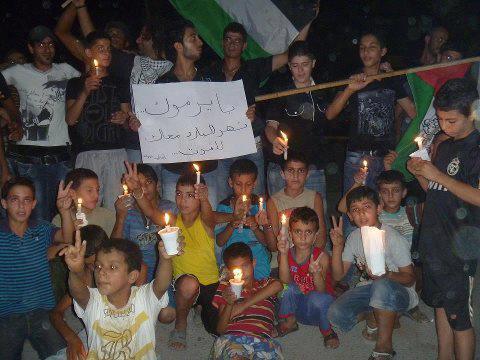

تضامن شباب في مخيم البارد مع مخيم اليرموك بعد المجزرة التي راح ضحيتها حتى الآن 24 شهيدا فلسطينيا وسوريا بعد قصف مخيم اليرموك أمس الجمعة بقذائف هاون، والي لا يزال يتعرض لاعتداءات من قبل قوات النظام في سورية. فبعد سقوط قذيفة هاون ولدى تجمع الأهالي للاطمئنان على ابنائهم سارعتهم قذيفة هاون أخرى فحصدت عددا كبيرا من الشهداء، كما نقل اتحاد شبكات أخبار المخيمات الفلسطينية
July 21, 2012
How I Failed the Thirsting for Justice Challenge
Yesterday my friend and I decided to take the Thirsting for Justice water challenge of living with 24 liters (that’s about 6 gallons for Americans) of water for 24 hours, which is something Palestinians in Palestine are forced to do every day. The challenge was created to educate people about the ways in which Israeli colonists control the water in Palestine even though all of the water sources are Palestinian. An infographic illustrates the problem quite well:
Just yesterday, for example, Israel demolished two Palestinian water cisterns, which, of course, meant that Palestinians who relied upon those water sources now do not have any access to water.
To begin this challenge I researched water consumption to get an idea about how much I might use each day. To be sure, my friend and I chose a difficult day because it was the day to clean the flat. This meant that we needed several buckets of water. We also needed to wash our clothes, but could not because the average washing machine requires between 80-170 liters of water (although we had conflicting information on this, we decided to lean towards the high end of the spectrum). So I had to wear some dirty clothes yesterday as a result.
Through my research about water I found some interesting facts about how much we waste when we don’t have to be conscious about our water usage:
the average Briton uses the equivalent of 16 buckets worth of water a day. One third of this goes down the loo
many people in the world exist on 10 litres of water or less a day, we use this in almost one flush of the toilet
Growing up in California, which does struggle with water issues, sometimes I was made aware of the hazards of taking long showers or flushing the toilet too much. But the water never ran out and so there is only so much of an impression that this warning had on me. Toilet waste is particularly important to think about given how much water it uses beyond what seems necessary. Consider these figures:
There are two types of toilets in my friend’s house. One is the typical type and the other is the kind that gives you a choice for a full or a half flush. Yesterday morning I opted for the half flush thinking that it might let me count a lower end of 9 liters instead of 16 liters. However, even that, when you realize that you only have 24 to use for the entire 24 hours, is too much. So I wasted around 9 liters too early in the day.
For the average American, here is what their indoor water consumption looks like (check out this link for the actual graphic which has enhanced features on the original):
When I tried to add up and estimate my daily usage, without considering how much water goes into cleaning my flat, I came up with a figure of about 234 liters (61 gallson) per day, 130 liters of which are devoted to toilet flushing. These initial figures are based on calculations that say we use 9.5 liters per minute when a faucet is one (for showering, washing hands, washing dishes, etc.). It also lowballs figures on washing clothes, partially because we use a front-loading machine, unlike the typical American top-loading machines, which seem to require more water.
Ultimately, we decided to use the handy water consumption chart on the Thirsting for Justice website:
Based on these figures here is how I failed the challenge:
I woke up, used the toilet, washed my face, brushed my teeth (with the tap off as usual): 12.4 liters.
I made coffee, drank some water, washed dishes (although I suspect washing dishes they way people do here, with the water off, requires less water than the way Americans do it by leaving the water running): 22 liters.
Then we both took showers. Rather than use the faucet, which according to the cart above, would at best require 35-50 liters for a 3 minute shower and at worst 75-90 liters for a 5 minute shower, we opted for a different option. Because even in the best case scenario above, if we only had 24 liters of water for the day, that would mean no shower at all. So we placed 3 liters of water into a pot and boiled it. We brought it into the shower and then split that amount between the two of us. My friend washed her hair, but I did not. This meant that we each used only 1.5 liters for showering.
But we failed when it came to washing the house. Because my friend has a large 3 bedroom flat, and because it requires about 7 buckets to clean the floors, each of which contains 10.5 liters of water, we used up 73.5 liters cleaning the house. And this only got us to the halfway point in the day.
After the house was clean, we made lunch. We washed vegetables, drank water, washed more dishes, and then brushed our teeth again. This required around 23 liters of water.
We spent the rest of the day outside the home where we drank more water (it is summer after all), ate more vegetables (which were washed), and ate off plates (that would then need to be washed). We went to the bathroom and washed our hands (but also used hand sanitizer at times to save the 1.4 liters it takes to wash one’s hands). We chose not to count this water because the 24 liters for 24 hours is for one’s household.
When we returned home I washed my face, brushed my teeth, drank some more water, which required another 4.4 liters.
My total water usage for the day was: 136.8 liters or 35.9 gallons.
Later this month I will try to do this again to see if I can do it on a day when I don’t need to clean the house. But in some ways I think this is a good way to test oneself because in most Palestinian homes, cleaning the house is a daily part of one’s activities.
I encourage others to try to meet this challenge. To sign up, you need only to visit the Thirsting for Justice website. There are a number of resources and fact sheets on the website to learn more about the way water theft accompanies land theft in Palestine. Also, here is an older Amnesty International report on how Palestinians are denied access to their own water. I also encourage people to donate to the Middle East Children’s Alliance Maia Project, which is helping to bring clean, fresh water to Palestinian children.
For those interested in water as an environmental issue more generally, there is an interesting UNDP report co-authored by youth entitled “Water Rights and Wrongs” that addresses the scarcity of water, the need for water, and water as a human right. Finally, I recommend this film Blue Gold, which explores the topic of water as a human right and an environmental more globally:
[image error]
Filed under: Activism, Apartheid, Colonialism, Environment, Human Rights, Palestine, Zionism Tagged: Amnesty International, blue gold, conservation, Maia Project, Middle East Children's Alliance, Palestine, thirsting for justice, undp, water


July 17, 2012
Greetings in Egypt
 When I arrived in Cairo on Sunday this billboard above is what greeted me. It is an ad for an Egyptian cell phone company with a quotation that is attributed to Barack Obama: “We must educate our children to become like young Egyptian people.” I tried looking for the source of this quotation, but all that emerged was a set of blogs or even newspapers listing quotes from world leaders about the Egyptian uprising. There seem to be no sources attributing where any of these quotations. But that is not the disturbing part of this billboard, of course. What is disturbing is both the cooptation of Egyptian people’s struggles for the purpose of capitalist consumption by using the words of a man who is actively involved in ensuring that the efforts of Egyptian people will lead to failure by supporting SCAF among other things. Mobinil began as an Egyptian company, but is now part of France’s telecom empire (see here for a post I wrote about what this means for normalization with Israel).
When I arrived in Cairo on Sunday this billboard above is what greeted me. It is an ad for an Egyptian cell phone company with a quotation that is attributed to Barack Obama: “We must educate our children to become like young Egyptian people.” I tried looking for the source of this quotation, but all that emerged was a set of blogs or even newspapers listing quotes from world leaders about the Egyptian uprising. There seem to be no sources attributing where any of these quotations. But that is not the disturbing part of this billboard, of course. What is disturbing is both the cooptation of Egyptian people’s struggles for the purpose of capitalist consumption by using the words of a man who is actively involved in ensuring that the efforts of Egyptian people will lead to failure by supporting SCAF among other things. Mobinil began as an Egyptian company, but is now part of France’s telecom empire (see here for a post I wrote about what this means for normalization with Israel).
I arrived in Egypt on the heels of Hillary Clinton’s visit to Egypt, which of course preceded her visit to meet with the enemy today. Thankfully, there were people greeting her in the streets with their shoes and tomatoes, which they threw at her car (they also taunted her by chanting “Monica,” which, yes, is misogynist, but I’m of the position that Hillary deserves all she gets and more). Below are some of the protest pictures.
Additionally, the images below are circulating in Egypt. You can read the translation of the Arabic from the first image on Angry Arab’s website. In essence, it is illustrating how not much has changed with the election of Mursi. The second one, also from Angry Arab, asks viewers not only to consider the similarities between Mubarak and Mursi, but also Clinton and Rice.
Although she’s gone now, Clinton’s next destination says everything about what this visit was really about: ensuring that the U.S. maintains hegemony over Egypt, particularly when it comes to the Camp David Accord with Israel. This has the potential to be abolished to the benefit of Egyptian and Palestinian people. Indeed, normalization with Israel has been a main issue on the table for activists at the center of the Egyptian uprising (among other things the storming of the Israeli embassy is one example of this as is the regular bombing of the Egyptian gas pipline to Israel). Just comparing the images of Hillary with Mursi (above) and the one with Lieberman says it all:
I don’t have time to enumerate the reasons for my loathing of Clinton. For those who are interested, here is some of my rationale. At the end of the day both Obama’s words greeting visitors and people returning home here in Egypt as well as Clinton’s visit is just a reminder for their ongoing imperial designs on the people of this country. And, again, Angry Arab’s take on this through a tweet by empire’s accomplice, Aaron David Miller, says it all:
“Aaron David Miller @aarondmiller2
the only real democrat in cairo today was hillary clinton. instead of one pharoah, Egypt now has two — the MB and the SCAF.”
So According to this Zionist White Man the one White Person of the US is a democrat, but not any of the 80 million Egyptians. He rules, of course. He alone, rules.
Filed under: Egypt, Hillary Clinton, Imperialism, U.S. Foreign Policy, Zionism



